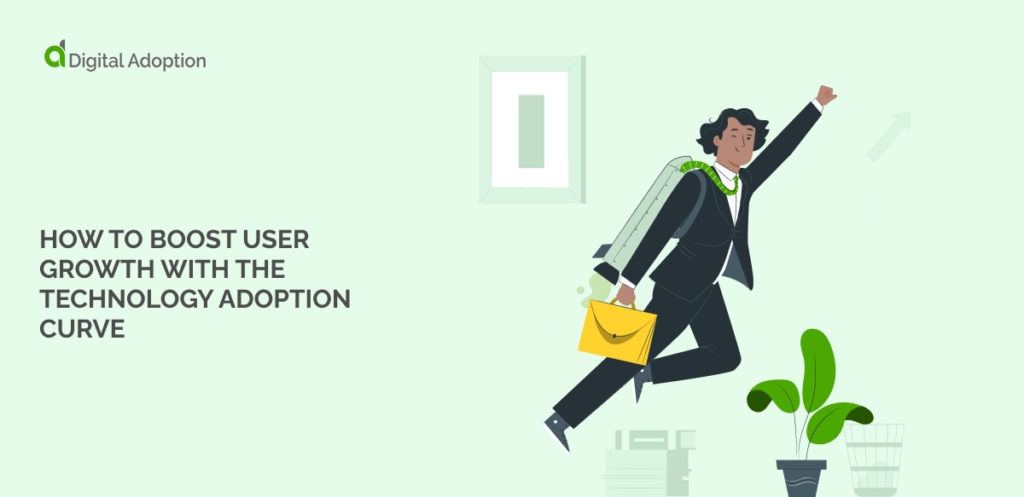The technology adoption curve is a useful model that can help businesses understand how innovations spread in societies – but it can also help product developers boost user growth.
Technology adoption statistics show that adoption timelines are shrinking. This means that it is increasingly important for product developers to use the technology adoption curve as a tool to understand how quickly consumers will adopt their innovation.
By understanding the technology adoption curve, developers can create better user experiences that cater to the needs of each user segment. Digital transformation initiatives are more likely to be successful when product developers understand the different types of users and their needs and motivations.
The idea of the technology adoption curve stems from the work of American social theorist Everett Rogers. In his book “Diffusion of Innovations,” Rogers studied the rate at which farmers adopted new hybrid seed corn. He depicted his findings in a graphic known as the Innovation-Adoption Curve.
Everett’s work has been adapted many times over the years, and it’s as applicable in today’s highly digital society as it was in the 60s when Everett wrote the book. The relationship between digital adoption and Everett’s work can be seen by understanding how it shapes product and software development.
The technology adoption curve is essential knowledge for any technology business. Using the technology adoption curve to inform your strategy can help boost user growth and enables you to cross the dreaded “chasm”— where many entrepreneurs are doomed to fail.
In this article, we’ll learn more about the technology adoption curve, including:
- The stages of the technology adoption life cycle.
- Why businesses need a different strategy for each step of the bell curve.
- How to fine-tune your business strategy to boost user growth at each stage.
Let’s start with the basics.
What Is the Technology Adoption Lifecycle?
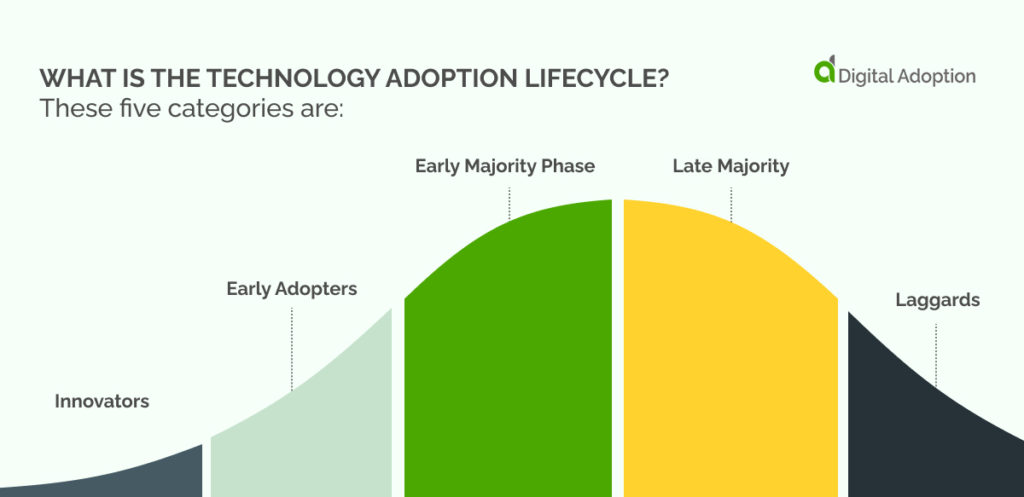
The technology adoption life cycle is a model that describes how technology spreads across societies and groups of people.
The model breaks society into five adopter categories. Each category has its own psychological characteristics which affect its attitude towards new innovations and technological change.
These five categories are:
- Innovators
Innovators account for about 2.5% of the total market share. They’re a small group passionate about new technology and are more open to taking risks to access the latest features.
Innovators are often content creators or developers who are deeply enfranchised and interested in beta testing. They are willing to accept the Minimum Viable Product (MVP).
They’re as likely to be industry professionals as they are to be passionate users sharing content on social media sites.
They value:
- Innovative products, novelty, and Unique Selling Points (USPs).
- Ambitious road maps.
- Cutting-edge features.
They don’t value:
- Stability.
- Social proof.
- The status quo.
- Early Adopters
Early adopters account for 13.5% of the market share.
They’re interested in new technology and willing to test new solutions before the mainstream accepts them. But they need proof of the merits of new technology before they throw their support behind it.
This is because they’re often opinion leaders. They might be professional content creators for established media brands. They stake their reputation on product recommendations and expect a little more refinement. This is what separates early adopters from innovators.
Early adopters don’t need all the kinks to be ironed out before they adopt new technology, but it has to be well on its way to a finished product.
Early adopters value:
- A chance to share their feedback.
- Their own reputation.
- Open communication on software updates.
- Early Majority
The early majority is the first portion of the mainstream users that adopt the product, who tend to be more open to new ideas. The early majority accounts for a solid 34% of the market share.
They’re interested in new technology but want proof of effectiveness. The early majority expect a finished product, free of bugs and errors.
Users in the early majority are logical, and their pragmatic approach to supporting new technology is largely data-driven.
The early majority values:
- Solid marketing.
- Real-life user stories.
- Proof of how new technology can solve their problems.
- Late Majority
The late majority is the portion of mainstream users who are more conservative and are typically skeptical of new technology. Users in the late majority account for 34% of the market share. Most larger enterprises are in the late majority.
The late majority are cautious of new technology and reject novelty. They want to see lots of good reviews.
Users in the late majority want a robust experience where all the kinks have been ironed out. They don’t value marketing or generic promises.
The late majority values:
- Lots of social proof.
- Low-risk solutions.
- Clear, guaranteed benefits.
- Laggards
Laggards are the most conservative group and the slowest to adopt new technology. They account for about 16% of the market share.
New technology frustrates laggards. They like to stick to what they know.
Appealing to laggards is difficult, as they usually aren’t interested in new features. Rather, laggards only adopt new technology when they have a problem they need to solve.
This could be that their current technology has stopped working, or they have a new requirement that their current technology doesn’t meet.
Rather than rely on marketing and user reviews, laggards are more responsive to recommendations from close friends or family members— only people they know and trust.
Laggards value:
- Clear benefits and solutions to their pain points.
- Evidence-based value propositions.
- Easy transitions to new technology
Generally, an early adopter is younger in age, richer, and has a more advanced education than late adopters.
These privileges make the early adopter less risk averse— a tendency businesses should tap into.
What is the Chasm, and How Can the Technology Adoption Lifecycle Help You Cross It?
In the 90s, Geoffrey Moore built upon Rogers’ Innovation-Adoption Curve in his book “Crossing the Chasm.”
Essentially, Moore proposed that there is a wide gap between the mindsets of early adopters and early majority adopter types.
This is where most new technologies fall—failing to ever see widespread adoption.
Crossing the chasm requires you to fine-tune your business strategy for each stage of the technology adoption lifecycle.
The benefits of doing this go beyond surviving the dreaded chasm, though.
By adapting your product or service, or your marketing strategy, for every stage of the technology adoption lifecycle, you can boost user growth across the board.
How to Use the Technology Adoption Life Cycle to Improve User Growth
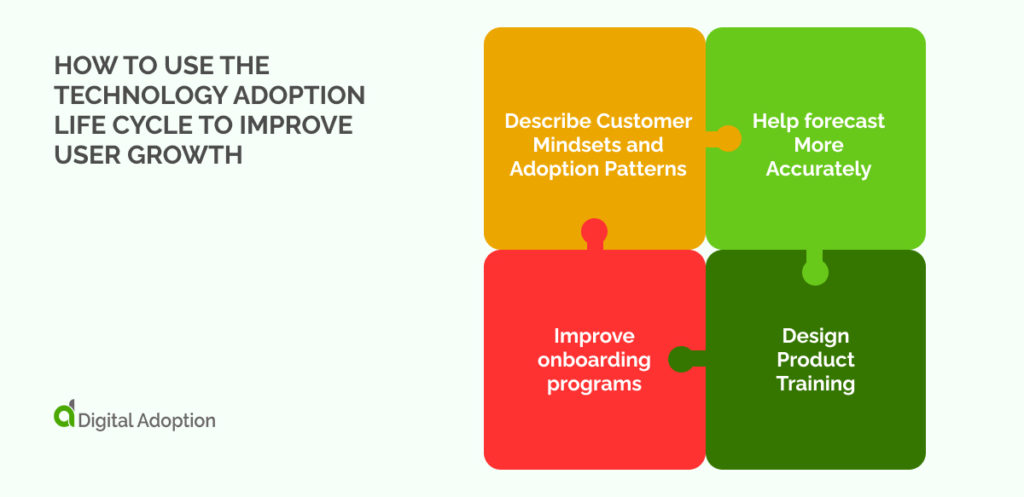
The technology adoption curve is a valuable way to describe the diffusion of innovative technology across society and large groups of people.
However, the same general rules apply to almost any audience, large or small. So, businesses can apply the technology adoption curve to their own target audiences.
Practically speaking, a product development company can use this model to:
Describe Customer Mindsets and Adoption Patterns
Applying this model to a customer base allows businesses to segment users into the same user groups: innovators, early adopters, early majority, late majority, and laggards.
We’ve covered the broad values of each group, but you can take this a step further.
Consider what each group wants from your product. What novelty does it provide? What catches the attention of early adopters?
What problems do you solve for laggards?
This will help you develop user personas and better educate your marketing efforts and development roadmap.
Help forecast More Accurately
A detailed analysis of the customers, the product, and the state of the market can help you predict how a product will perform in the marketplace by forecasting things like:
- Adoption patterns
- Product viability
- Revenue potential
Better forecasting can help you plan your roadmap and give stakeholders or potential investors desirable knowledge.
Design Product Training
Adoption is negatively impacted when products are too far ahead of their users. Practical product training can close this gap and improve usability.
Innovators and early adopters only need training on what’s new. You’re just as likely to learn from the early market as they are to learn from you.
But robust documentation can be a major selling point in the later stages of the adoption lifecycle.
So you will need to develop product training, but you don’t have to prioritize it in the earlier stages.
Improve onboarding programs
Good analysis of the user base can help product teams design customer onboarding programs that fit the adoption segment of their audience.
Innovators and early adopters want to get started right away. They want to cut to the chase. Your onboarding process should reflect this and be short, sweet, and agile.
The early majority is different, alongside the late majority and laggards. They want to make sure their basic needs are met. They want to find a sense of familiarity with new technology. At these stages, your onboarding process should be meticulous and in-depth.
How to Use the Technology Adoption Cycle to Inform In-House Digital Adoption Programs
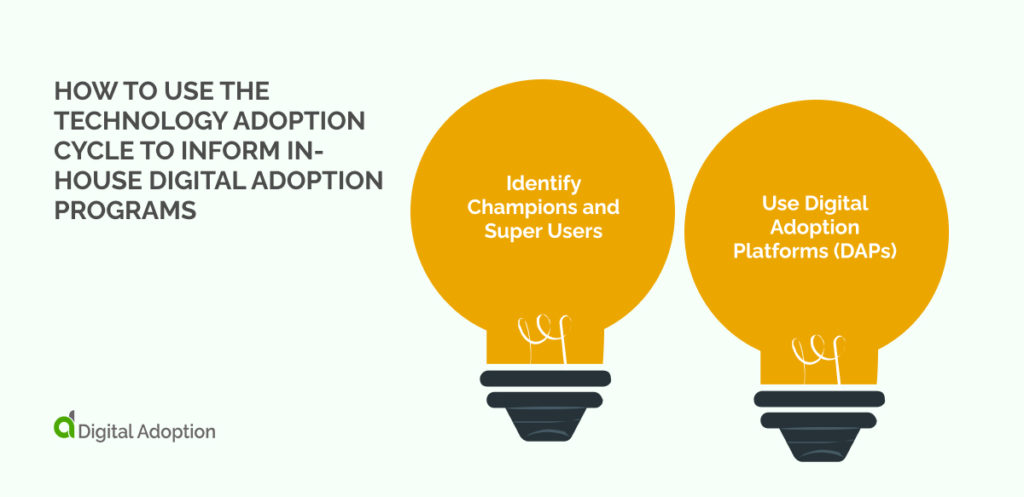
Many major principles driving user growth are the same whether you’re looking at external customer adoption or in-house employee adoption.
But, there are a few key differences, mainly stemming from the fact that when it comes to in-house adoption, users are more likely to collaborate and more incentivized to adopt new technology.
For example, a business rolling out a new project management tool can, to an extent, mandate its adoption. That just isn’t possible in the free market.
Here are a couple of tips on boosting in-house user growth:
- Identify Champions and Super Users
Innovative, early adopters are ideal super users and change advocates. These users are a vital driving force in adopting new internal technology.
They can train other users, and you can ask them to provide statements of value. They’re leaders on the ground who can help to keep users in sync with the adoption programs.
- Use Digital Adoption Platforms (DAPs)
DAPs have software analytics that can offer insight into user behavior, helping to segment and understand employees, streamline adoption, and more.
You can also use them to reinforce and improve the training process.
This means they generate valuable information in the early stages of the adoption lifecycle and help more stubborn users along their journey.
Other Ways to Look at the Technology Adoption Process
The technology adoption curve can be helpful in many circumstances, from digital adoption to customer growth.
However, the model presented in this article is just one way of looking at things.
To gain a deeper understanding of the concept, consider checking out some of these further reading materials:
- The Bass Diffusion Model describes how technology is adopted across populations.
- The lazy user model describes how individual users choose a solution.
- Gartner’s hype cycle describes how technology matures and is adopted within society.
- The technology acceptance model is another model that describes how users adopt an innovation.
Different Strategies for Different Markets
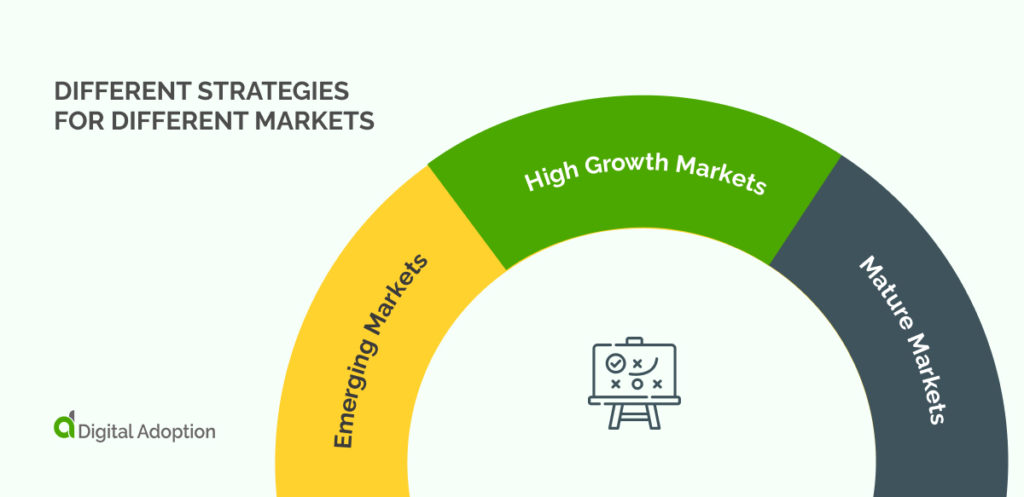
Here’s another way to look at all this:
Where your product or service sits on the technology life cycle is usually a reflection of the state of the market.
If you’re targeting innovators and early adopters, you’re probably in an emerging market.
If you’re targeting the early and late majority, you’re probably in a high-growth market.
If you’re targeting laggards, you’re probably in a mature market.
Different markets call for different strategies. For example:
- Emerging Markets
In an emerging market, you want to build momentum. Agility is key; you must be ready to have a tight feedback loop with innovators and early adopters. While all this is going on and you continue to iterate on your product or service, you must also begin preparing to transition into a high-growth market.
- High Growth Markets
By the time you’re in a high-growth market, you should know what your advantages are. Product development can be put on the back burner in favor of marketing and sales.
The biggest challenge in a high-growth market is preparing for rapid growth. Whether that means you need better infrastructure, user support, manufacturing— whatever it is, be ready to scale it up.
- Mature Markets
You can expect fierce competition in a mature market as other businesses learn from your innovations and jump on the bandwagon.
You can combat market saturation by prioritizing innovation and finding new ways to create value for consumers.
Remember that “the chasm” exists in transitioning from emerging to high-growth markets. This is where your business is most at risk of failing. Be prepared for that.
The Future of The Technology Adoption Curve
The technology adoption curve is a term that refers to how users of a particular technology adopt it over time. It typically follows an “S” shaped curve where the early adopters are followed by the majority, who eventually become the late majority, and finally, the laggards. As we move further into the future, this trend will continue but with more rapid adoption of technology as a whole.
As the cost and complexity of technology decreases, more people will be able to access it, leading to greater adoption rates. Additionally, the increasing availability of artificial intelligence (AI), machine learning (ML), robotics, and connected devices are likely to drive further advances in technology adoption.
The effective use of these models can significantly impact user growth, product adoption, product design, and more.
This is just one way to better understand customer behavior and purchase patterns, helping you build accurate personas of who is buying your product or service.
Not only does this let you specialize your marketing and development efforts, but it also shows you which areas you can afford to prioritize lower than others. This is invaluable information in startup or project culture when resources are spread thin enough.

